
Research Article
Austin J Forensic Sci Criminol. 2023; 10(1): 1091.
Latent Fingerprint Development by Brick Powder
Rakesh Mia¹*; Vijay Panchal¹; Preeti Dangi²; Chanchal Kamle²; Asutosh Tripathi³
¹Applied Forensic Research Sciences, Indore, India
²Depertment of Forensic Science, Government Holkar Science College, India
³HOD, Institute of Sciences, Department of Forensic Science, SAGE University, India
*Corresponding author: Rakesh Mia President of Applied Forensic Research Sciences, Indore, MP, India. Tel: +91 9366381689 Email: rmia8207@gmail.com
Received: February 20, 2023 Accepted: April 04, 2023 Published: April 11, 2023
Abstract
In forensic investigations, the relationship between the criminal, the victim, and the crime scene can be firmly established through the detection of latent finger marks. Fingerprints are avital and unique identity of a person. These are impressions left by the friction ridges of a human finger on contact with any surface. Many unique characteristics in the human body like a fingerprint, DNA, palm prints, iris patterns, voices, etc. So, Fingerprint is a unique characteristic of the human body, and every human’s different fingerprints between identical twins. As we know friction ridges develop in a 3-4 month of gestation duration time. Mayer, a German doctor, and anatomist were the first to write that friction ridge skin is unique. The fingerprint is the most important evidence at the Crime scene and identification of the criminal. Fingerprint identification is a method of identification using the impression formed by the minute ridges seen on the fingertips. Fingerprint has certain individual characteristics that are unique. Latent fingerprints are most generally seen prints from the crime scene. Such prints are obtained when natural oils and perspiration existing between the fingertip ridges are transferred to a surface by any contact. Latent prints are invisible and are much harder to detect and preserve. In this research paper, a new method for the development of Latent fingerprints is used that’s brick powder. The brick powder is used in various Porous and Non-porous surfaces like plastic glass, ordinary mirror, matchbox, painted wall, writable CD, wooden substrate, currency note, door handle, floor surface, book cover, sunglasses, and mobile glass card for development of latent fingerprint impression.
Introduction
Based on Locard's exchange principle as “Every contact leaves traces” the latent fingerprint is the most encountered print from the crime scene. Which is unconsciously left by the criminal at any surface in the crime scene? The process of enhancement is necessary for the latent fingerprint to be observed by the naked eye. The Palmer surface of the hand and feet are covered by a layer of folded skin. Which ensure various activities. The raised surface is known as a papillary which is also called a friction ridges [1-4]. The reproduction of the pattern of the friction ridges on the distal phalanges of the finger and thumb are called as a fingerprint. We know all, Unique characteristics in our human body like DNA, fingerprint, voice, iris, etc. The most important thing is fingerprint is unique. In the criminal justice system, fingerprint evidence is primary evidence at the crime scene. The fingerprint features like unique, permanent, universal, classifiable. Fingerprints of twins are also different. Fingerprint can be used in personal identification system, the idea was first proposed in 1858 by the District Magistrate of Hooghly District of Bengal, Sir William Herschel. Later, Dr Henry Fades gave the idea that criminals could be discovered from latent prints found at the crime scene and came to the conclusion that two fingerprints cannot be the same. Fingerprint examination has been the keystone of forensic examination for over 100 years. Three main types of fingerprint present at the Crime scene First is visible or patent, second is invisible or latent, third is plastic or 3D fingerprint [5]. The crime scene investigators often follow a two-stage process when searching for fingerprint at the crime scene. First stage, they look for a patent or visible and plastic or 3D print since they are visible or not, often times a flashlight is used during this time. The second stage involves a blind search for Latent prints. The Latent prints impression recovery at any crime scene is one of the most challenging parts of Forensic science because that latent or invisible physical evidence can often give evidence of appreciation related to the reconstruction of the scene [6-8]. Nowadays in our India, every forensic science expert used chemical, physical and instrumental method for the detection of Latent fingerprint impression. Basically, in this paper, we introduced a new method for easily detect the latent fingerprint impression at the crime scene. For the decipherment of such finger impression the traditional fingerprinting detection techniques for treating latent print is powdering method Which has been used since 1900s. Which is based on powder adhesion? Various fingerprint powder formulation have been reported for the department of latent fingerprint. Which may not always effective and having some limitation [9].
Material and Method
In the present study, the latent or invisible fingerprint impression 12 Samples are collected and developed to the various porous and non-porous surfaces i.e., a plastic glass, ordinary mirror, matchbox, painted walls, writable CD wooden, subtracts, currency note, door handle floor surface, book cover, sunglasses, mobile glass card. The following surfaces developed by the brick powder. The method used for the development of latent or invisible fingerprint is powder dusting method [10-15]. It is a physical method for enhancement of latent fingerprint. This method is mainly based on the adherence of fine fingerprint powder particle on the traces of sweat, oil and other natural secretion of skin which is released through ridge pores of skin and forms a mirror image of ridge pattern. After that the method is applied firstly the suspected area is located then the fingerprint powder is sprinkled over the suspected area and the powders attached to the oils and other constituents of the sweat left in a fingerprint. So based on the principal [16-21], the brick powders have very fine particles to put on crime scene or suspected area and used camel hair brush develop the invisible or latent fingerprint sample. After developed the fingerprint impression Forensic photography was taken and lift the cellophane tape and put on the various contrast area and fingerprint pattern is clearly seen also which type of print is there, it’s clearly identified and preserved the using powder sample. The fine particles of the powder adhere the print, hence the ridge characteristics are clearly visible.
Result and Discussion
The result of the current study showed the development of latent or invisible fingerprint on various non-porous surface by the brick powder by using this powder or questioned surface it provide better result on both dark and light color non-porous surface due to the colour contrast of the powder [22-25]. The visualization of latent finger impression on the surface of plastic glass, ordinary mirror, matchbox, painted walls, writable CD wooden, subtracts, currency note, door handle floor surface, book cover, sunglasses, mobile glass card is successfully done which the pictorial result shown from (Figure 1 to Figure 12). Thus, this result produce by following oldest powder dusting method with fine particles of this powder provide good adherence on latent residue of latent impression that present in the form of natural human perspiration and deposited on to the questioned surface. Due to the adherence of particle it provides clear visibility of fingerprint impressions. Which lead prominent factor in terms of fingerprint identification at a criminal offense. The developed result shows the clear visibility of ridges pattern. These result advices that this brick powder is to be successfully employed as a new powder method on various non-porous surface for the enhancement of the latent finger prints except wet non-porous surface [26-28]. This investigation is done with identification and examination of this powder on different surfaces which shows clear visualization of latent fingerprints and Ridge characteristic. It is also observed that after development of latent finger impression on various non-porous surface it is also clearly visible up to 2-3 days. Even it does not fade until and unless without any destruction onto the surface it provide a positive impact. In case of secondary collection of Finger impression through photography.

Figure 1: Developmental of latent fingerprint with help of brick powder on porous serface currency note.

Figure 2: Development of latent fingerprint with help of brick powder non porous ordinary mirror.
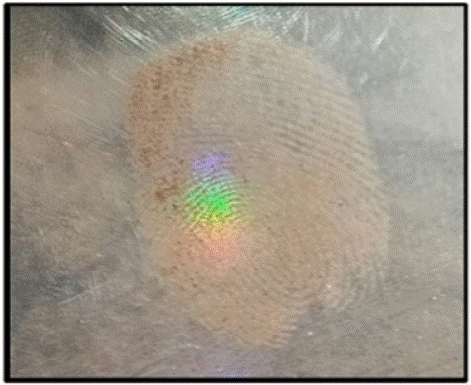
Figure 3: Development of latent fingerprint with help of brick powder on one porous serface write table CD. powder non porous ordinary mirror.
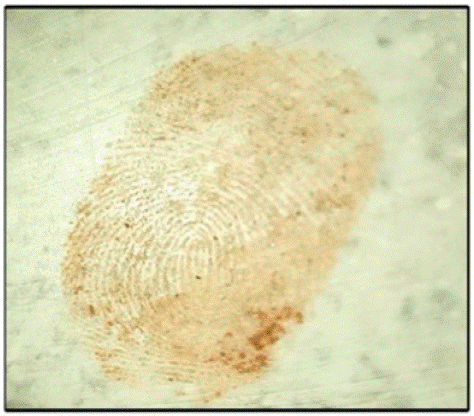
Figure 4: Development of latent fingerprint with help of brick powder on none porous floor surface.
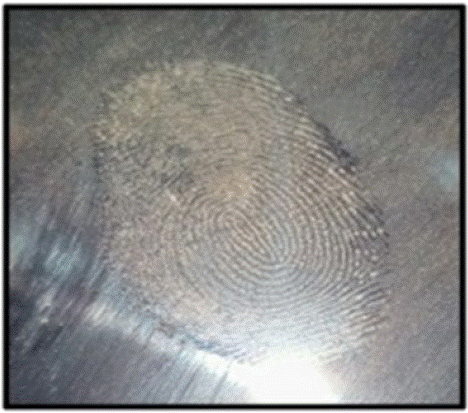
Figure 5: Development of latent fingerprint with help of brick powder on none porous mobile glass card.

Figure 6: Development of latent fingerprint with help of brick powder on porous painted wall.

Figure 7: Development latent fingerprint with the help of the brick powder on porous match box.
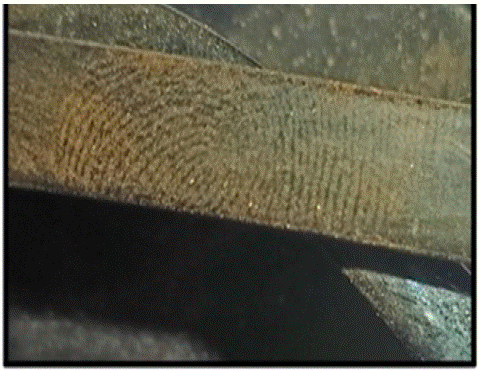
Figure 8: Development latent fingerprint with the help of the brick powder on non porous sun glasses.

Figure 9: Development latent fingerprint with the help of the brick powder on porous serface currency note.
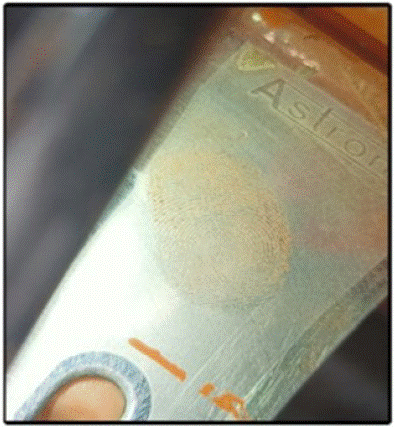
Figure 10: Development latent fingerprint with the help of the brick powder on non porous door Handle.
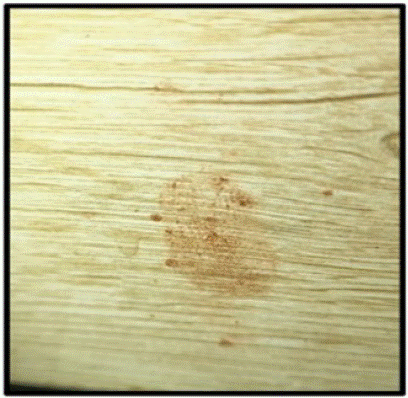
Figure 11: Development latent fingerprint with the help of the brick powder on non porous wooden substract.
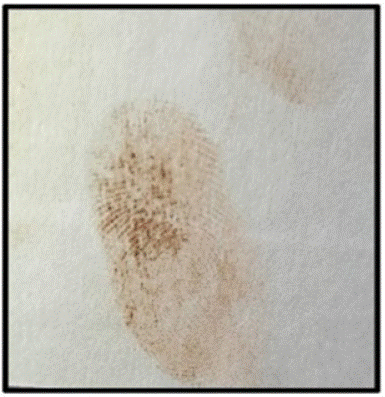
Figure 12: Development latent fingerprint with the help of the brick powder on porous book cover.
Conclusion
The current study of the Research paper, any bricks are easily available at any places like home, school, college, office etc. In this process nothing coming is high cost. In many cases forensic expert doesn’t have latent fingerprint development powder when they are reached at the crime scene so burnt paper powder can be used to develop latent fingerprint and solving a major crime scene. There are various fingerprints powder is available which is chemically formulated that is expensive and leads potential harm to health. This newly introduced powder is also overcome with it. In last, this kind of brick paper powder easily visualization latent fingerprint impressions at the any scene of a crime.
References
- Penrose LS, Ohara PT. The development of the epidermal ridges. J Med Genet. n1973; 10: 201-208.
- Muewly D. Forensic industrialisation from biometric data. Sci Justice. 2006; 46: 205-213.
- Hinder SJ, Watts JF. SIMS fingerprint analysis on organic substrates. Surface and Interface Analysis. 2010; 42: 826-829.
- Kassin SM. The psychology of confession evidence. Am Psychol. 1997; 52: 21-33.
- Crane NJ, Bartick EG, Perlman RS, Huffman S. Infrared Spectroscopic Imaging for Noninvasive Detection of Latent Fingerprints. J Forensic Sci. 2010; 52: 48-53.
- Lin AC1, Hsieh HM, Tsai LC, Linacre A, Lee JC. Forensic Applications of Infrared Imaging for the Detection and Recording of Latent Evidence. J Forensic Sci. 2007; 52: 1148-1150.
- Garg RK, Harish K, Ramanjit K. A new technique for visualization of latent fingerprints on various surfaces using powder from turmeric: A rhizomatous herbaceous plant (Curcuma longa). Egyptian J Forensic Sci. 2011; 1: 53-57.
- S Prabhakar, AK Jain. Decision-level fusion in fingerprint verifi cation. Pattern Recognition. 2002; 35: 861–874.
- Jasuja OP, Singh GD, Sodhi GS. Development of latent fingerprints on the sticky side of adhesive tapes: Phase transfer catalyst-based formulation. Canadian Society of Forensic Science Journal. 2007; 40: 1–13.
- Fitzi T, Fischer R, Moret S, Becue A. Fingermark detection on thermal papers: proposition of an updated processing sequence. J For Ident. 2014; 64: 329–350.
- Hahn W, Ramotowski R. Evaluation of a novel one-Step fluorescent cyanoacrylate fuming process for latent print visualization. J For Ident. 2012; 62: 279–298.
- Sodhi G, Kapoor S, Kumar S. A multipurpose composition based on Brilliant Blue R for developing Latent fingerprints on Crime Scene Evidences. Journal of Forensic Investigation. 2012; 2: 3.
- Wood M, James T. Latent Fingerprints Persistence and Development techniques on wet surfaces. Fingerprint World. 2009; 35: 90-100.
- Kumari H, Garg RK. New visualizing agents for latent fingerprints: Synthetic food and festival colors. Egyptian Journal of Forensic Sciences. 2011; 1: 133-139.
- Singh K, Sharma S, Garg RK. Visualization of latent fingerprints using silica gel G: A new technique Egyptian Journal of Forensic Sciences. 2013; 3: 20–25.
- Lee HC, Gaensslen RE. Methods of latent fingerprint development. Advances in Fingerprint Technology. 2001; 2: 105–176.
- J Plerkaitis- Journal of forensic identification, 2007-search-proquest.com Maltoni D, Maio D, Jain AK, and Prabhakar S. 2009.
- Handbook of fingerprint recognition. Springer Science and Business Media Hanukoglu I, Boggula VR, Vaknine H, et al. Expression of epithelial sodium channel (ENaC) and CFTR in the human epidermis and epidermal appendages. Histochemistry and Cell Biology. 2017; 147: 733–748.
- Rohatgi R, Kapoor AK. Development of latent fingerprints on wet non-porous surfaces with SPR based on basic fuchsin dye. Egypt J Forensic Sci. 2016; 6: 179–84.
- Badiye A, Kapoor N. Efficacy of Robin® powder blue for latent fingerprint development on various surfaces. Egypt J Forensic Sci. 2015; 5: 166–73.
- Almog J, Azoury M, Elmaliah Y, Berenstein L, Zaban A. Fingerprints’ third dimension: the depth and shape of fingerprints penetration into paper — cross section examination by fluorescence microscopy. J Forensic Sci. 2004; 49: 981–985.
- Archer N, Charles Y, Elliott J, Jickells S. Changes in the lipid composition of latent fingerprint residue with time after deposition on a surface. Forensic Sci Int. 2005; 154: 224–239.
- Cadd S, Islam M, Manson P, Bleay S. Fingerprint composition and aging: A literature review. Sci Justice. 2015; 55: 219–238.
- Kapoor S, Sodhi G, Sanjiv K. Visualization of Latent Fingermarks using Rhodamine B: a new method. Int J Forensic Sci Pathol. 2015; 3: 199–201.
- Soltyszewski I, Moszczynski J, Pepinski W, Jastrzebowska S, Makulec W, et al. Fingerprint detection and DNA typing on objects recovered from water. JFI. 2007; 57: 681–687.
- Niranjan H, Shweta R, Kapil R, Chanchal K, Rakesh M. Unconventional powder method is a useful technique to determine the latent fingerprint impressions. J Forensic Sci Res. 2022; 6: 045-048.
- Rakesh M, Ashutosh T, Chanchal K, Riya S, Vijay P, et al. Development of Invisible Fingerprint Impressions Using Medicine Powder. Indo Am JP Sci. 2021; 08: 127-132.
- Mia R, Panchal V, Gokhale C. Using Salt & Sugar Powder to Development Hidden Fingerprint Impressions at the Crime Scene. Int J Forens Sci. 2021; 6: 000232.